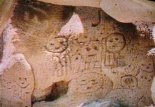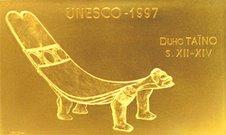
Rostro de un indio taíno
Foto: Jorge Luis Merencio y archivos del Museo Arqueológico(For the English version of this story click on article title above photo)*
Restauradores del Museo Arqueológico de Baracoa y antropólogos extranjeros reprodujeron el rostro del taíno cuya osamenta se cree pertenezca al líder GuamáPor: Lisván Lescaille Durand
Correo:
corresp@jrebelde.cip.cuBARACOA, Guantánamo.— Cualquiera sea la identidad del indio cuyo cadáver fue encontrado en febrero de 2003 en las serranía de Boma, en la primera de nuestras villas y ciudades, no caben dudas de su espíritu inquieto. Se resiste al sosiego de las almas en manos de Hades. Quiere revelarnos su historia. Ahora, presumiblemente, da la cara a la modernidad.
Un equipo de restauradores del Museo Arqueológico baracoense Cueva El Paraíso, con la colaboración de antropólogos extranjeros, reprodujo el rostro del taíno, cuya osamenta, exhibida allí, se cree pertenezca al cacique Guamá.
La presunta imagen del líder indocubano —protagonista de la más cruenta, larga y efectiva rebelión aborigen contra el exterminio de España en Cuba, entre 1522 y 1532—, se obtuvo a partir del cráneo del cadáver descubierto a principios de 2003 en la cueva La Vigía, con numerosas evidencias histórico-arqueológicas que lo relacionan con Guamá.
Durante más de seis meses los expertos trabajaron en la confección de un molde de yeso con la cavidad craneana del extinto, y aplicaron la técnica de pivote para el apuntalamiento del tejido blando facial alrededor de la cara, informó a JR uno de los autores, el joven restaurador Andrey Guilarte.
"Vaciamos en yeso el molde original del cráneo del cadáver y le colocamos 32 pivotes en torno a su fisonomía, luego se rellenó el rostro con una plastilina especial hasta lograr los detalles específicos", explicó Guilarte.
"Se trata de un complejo proceso que requirió tiempo, precisión y exactitud, indispensables para acercarnos fielmente a la imagen del nativo estudiado", abundó el coautor del proyecto junto a los también escultores Noel Coutín y Bernardo Milhet, además de la arqueóloga estadounidense Sharyn Thompson, la canadiense Susan Hurlich y la colaboradora local Yanexi Pelier.
"Posiblemente esta sea la primera reproducción fisonómica de un arahuaco realizada en Cuba, al menos que tengamos noticias", opina el profesor Roberto Ordúñez Fernández, director del museo y de la Sociedad Arqueológica de Baracoa.
EVIDENCIAS QUE PESAN
El investigador Ordúñez es el más fervoroso defensor de la teoría de que el individuo de marras puede ser Guamá o alguien muy influyente dentro de la jerarquía taína. Su hipótesis gana sustento con los resultados de la prueba de carbono 14, conocidos en agosto de 2004.
Una muestra de basura arqueológica recogida en el lugar del hallazgo, y examinada por expertos internacionales, arrojó que el cadáver yacía en un sitio de enterramiento de los llamados grupos arcaicos, llegados a Cuba 160 años antes que los taínos.
La edad estimada es de 1020 AP (Antes del Presente). El año de la muestra es + 0 -20, o sea 472 años antes de la llegada de Colón a Cuba y 160 años antes de los grupos agroalfareros. Por tal razón la cueva de donde se extrajeron los residuos de basura arqueológica estuvo habitada por un grupo humano alrededor del año 1000 d.n.e.
"El cadáver objeto de investigación pertenece, por la deformación fronto-occipital y el ajuar cerámico, a los grupos taínos que arribaron a nuestras costas a partir del año 1100 o 1200 de nuestra era", sostiene el arqueólogo Ordúñez.
"Tratándose del único entierro ceramista en la gruta del hallazgo, suponemos que este cadáver fue trasladado a un contexto funerario de los grupos arcaicos, por razones aún desconocidas, aunque puede suponerse que lo escondieron o practicaron algún culto especial."
"No se puede olvidar que ya en época de la conquista se estaba llevando a cabo la práctica bochornosa, por parte de los españoles, de profanar y saquear las tumbas aborígenes para robar las riquezas de altos personajes de esas comunidades", considera Ordúñez.
La osamenta que se exhibe en el Museo arqueológico de Baracoa perteneció a un individuo que fue sepultado en la posición de cuclillas y a su alrededor se colocaron objetos y piezas ceremoniales típicos de los enterramientos indígenas: "una esferalita, muy grande, según el rango del personaje; un collar de serium con amuleto colgante; una cazuela con ofrenda de caracolus-caracolus y polidantes, obsequio para el viaje al ultramundo, además de otras piedras ceremoniales", recuerda Ordúñez Fernández.
Precisa el especialista que el esqueleto encontrado tiene una fractura en la frente, resultado de un golpe mortal, a lo cual se une la confirmación, mediante peritajes, de que se trata una persona masculina, de algo más de 40 años, lo cual coincide con las señas de Guamá.
Y para colmo de coincidencias, la sombra de una presumiblemente atractiva mujer adereza esta enigmática historia. Existen documentados testimonios —reitera el profesor Ordúñez— que confirman la muerte del líder indígena no por las balas españolas, sino de un hachazo en la frente propinado por su hermano Olguama, mientras el cacique dormía. La agresión pudo estar impulsada por los celos, ya que Guamá raptó a la cuñada, según atestiguaron indios de esa guerrilla.
"Cuando tengamos los resultados del ADN —una prueba muy costosa que acomete el antropólogo noruego Richard Daly—, podríamos tener la antigüedad exacta del personaje, las enfermedades que padeció, los alimentos que consumía y con ello su ubicación en el área geográfica del descubrimiento, entre otras valiosísimas informaciones", sostiene el director del Museo Arqueológico de Baracoa.
*******************************************
Guamá: un héroe no suficientemente estudiado
La vida de este indio que conocía las serranías de Baracoa como la palma de su mano no ha sido suficientemente estudiada. Como afirma Juan Jiménez Pastrana en su libro Guamá, "el cacique no tuvo la suerte de que sus hechos heroicos fueran divulgados por el padre Las Casas en sus famosas crónicas: sus acciones fueron ignoradas o poco conocidas...".
Sin embargo, está documentado que provocó quebraderos de cabeza a los gobernadores de la Isla en esa década de explotación y exterminio. En 1522 se internó en las montañas de Baracoa con 50 bravos guerreros y puso en práctica la guerra de guerrillas, luchando con arcos, flechas, macanas y hachas de piedra contra las lanzas, espadas y arcabuces españoles.
Incendió en varias ocasiones el poblado de Baracoa, asaltaba haciendas de los conquistadores y sumaba a los indios a la contienda. Se ha podido conocer, según el profesor Ordúñez, que Guamá llegó hasta la región de Camagüey e intentó unir a otros caciques y negros africanos para la rebelión contra los españoles. 










